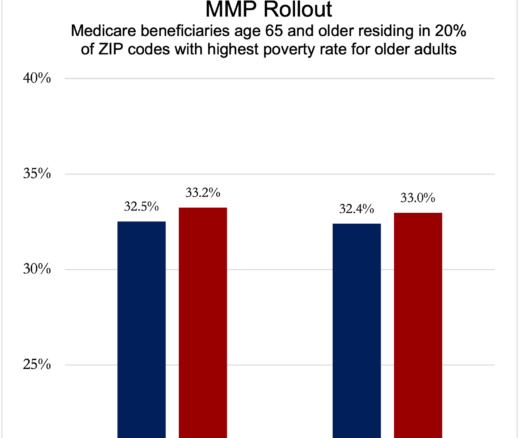
Integrated Care Plans Didn’t Boost Medicaid Enrollment for the Poorest Seniors
Chart of the Day: Medicare-Medicaid Plans—Created to Streamline Care for Dually Eligible Individuals—Failed to Increase Medicaid Participation in High-Poverty Communities
Blog Post

Children who had to stay in the hospital even after they were medically cleared to leave waited an average of 30 days before being able to transfer to a more appropriate facility, according to data from a large urban children’s hospital.
Information from other facilities paints an even more concerning picture, with a 2019 study finding that children with complex conditions waited an average of 52 more days after being medically cleared to leave due to delays with establishing home nursing and other challenges.
What’s more, evidence suggests that there are racial disparities in children’s length of stay, meaning this problem disproportionately affects minority families.
Unfortunately, there is no way to estimate the length of such wait times nationally, as the current measure of “unnecessary hospital days” also includes short-term delays for services like specialist visits and lab orders.
In response to the problem of missing data and avoidable delays more broadly, a team including Penn LDI Associate Fellow Zoe Bouchelle, Senior Fellows Evan Fieldston and Chén Kenyon, Children’s Hospital of Philadelphia (CHOP) Senior Director of Case and Care Management Michele Hillman, and CHOP Pediatrician Emma Hackel offered their perspective on what should be done. We asked them to explain more about the situation and their recommendations.
Right now in our hospital there are more than 40 children waiting to be discharged. Most are delayed due to a lack of nursing facility beds or nursing staff and a lack of behavioral health care placement, while others are awaiting placement by the Pennsylvania Department of Human Services.
In 2021, children at our hospital awaiting facility placement or private duty home nursing had an average delay of 30 days. That is, they remained in the hospital for an average of 30 days after the point of medical clearance.
They fall into three general groups: children with behavioral health needs (a rapidly growing population, as covered recently by the New York Times), children with complex medical conditions, and children with involvement in the child welfare system.
In the case of children with complex medical conditions, technology-dependence, such as the need for tracheostomy and ventilator due to pulmonary or neurologic disease, makes it difficult for parents and caregivers to provide all the needed home care. Thus, many of these children need shift-based, highly-skilled home nursing care, which is in short supply. Even children with relatively ‘simple’ home-nursing needs may have prolonged wait times because of nurse staffing shortages across the board.
Some children fall into multiple groups at once. Children in foster care are more likely to have medical needs and behavioral health needs. The intersection of these challenges can further delay hospital discharge.
Research investigating root causes is sparse. With that said, one common theme is a mismatch between a patient’s needs and existing resources. For example, medically complex children may experience delays because there is a lack of available home-care nurses, children who need inpatient psychiatric care may experience delays because inpatient psychiatric care systems are overwhelmed, and children who require foster care placement may experience delays because there are too few foster families or inadequate services to support family-of-origin reunification. Hence, these children must wait until resources become available, which can take days, weeks, or months.
Hospitals are normally responsible for the brunt of the costs. For children waiting for psychiatric or foster placement, insurers typically do not reimburse the hospital past the point of clearance, making them responsible for thousands of dollars in costs per day, while patients are held responsible for co-pays and deductibles.
For children with medical complexities, some insurers will bundle payments to hospitals for prolonged stays which are typically far below the usual per diem reimbursement rate.
For any of these children, an insurer may deem that a patient no longer requires care in an acute hospital and stop paying. These costs are then absorbed by the hospital, unless the hospital successfully pursues an appeal by an External Review Organization.
Children who reside in the hospital even after being medically cleared miss out on all the aspects of regular life. These can include school, time with family and peers, and time outdoors, with all the associated developmental and psychological impacts. Furthermore, the children most likely to have a discharge delay are also the most likely to need frequent, long-term therapies, which are not typically offered in the hospital setting.
While investing in resources to arrange a safe transition for children from the hospital to the community is costly, there are also high costs associated with keeping children in the hospital after the point of medical clearance. Hospitals may not be reimbursed for additional days or months of a patient’s stay past their medical clearance. These long stays also pose a higher risk for children’s physical and mental health in terms of infection risk and lack of behavioral health services, further exacerbating their symptoms and making discharge increasingly more difficult.
Additionally, the beds occupied by medically cleared patients are unavailable to other children who do require acute care services. This can impede acutely ill children from receiving needed care when hospital census is high, as during the respiratory viral surge in fall 2022. Finally, while initial costs for establishing home nursing and long-term care facilities may be high, these locations have a lower per diem cost than an acute care hospital, resulting in lower costs over time. The costs of investing in new structures to serve patients must be considered in relation to the costs of not investing in these new structures.
One example we highlight in the piece is the Integrated Care for Kids (InCK) Model. It is designed as a child-centered state payment model with the goal of reducing expenditures and improving the quality of care for children under 21 years old insured by Medicaid. It aims to do this through prevention, early identification, and treatment of behavioral and physical health needs. Under the model, which is currently in a pilot phase with seven states, health care organizations, managed care organizations, public health departments, schools, child welfare agencies, and community organizations engage in more proactive case management and care coordination.
In North Carolina, for example, improved cross-sector data sharing will allow the NC InCK program to identify high-risk children and provide them with a family navigator to help improve integration between their health care team and other stakeholders like juvenile justice, schools, and child welfare. NC InCK is also developing an Alternative Payment Model with Medicaid to link incentive payments to more meaningful measures of child well-being, like food, housing insecurity, and mental health concerns; as well as health care utilization metrics like total costs of care and emergency department visits.
A benefit of this approach is that it focuses on early intervention so children can get treatment sooner. This means that more care may be provided in home- and community-based settings, rather than in the emergency department or hospital.
One could envision a similar cross-sector collaborative model that occurs after hospitalization to facilitate timely discharge and prevent rehospitalization.
While the hope is that this payment model would reduce disparities, metrics need to be tracked to detect any emerging disparities in care.
Policymakers should advocate for more open sharing of information to foster collaboration among hospitals, behavioral health organizations, child welfare agencies, and other stakeholders.
The perspective, “Avoidable Discharge Delays: Children Waiting in Hospitals Deserve More Attention,” was published on February 23, 2023 in Hospital Pediatrics. Authors include Emma J. B. Hackel, Zoe Bouchelle, Michele Hillman, Evan Fieldston, and Chén C. Kenyon.


Chart of the Day: Medicare-Medicaid Plans—Created to Streamline Care for Dually Eligible Individuals—Failed to Increase Medicaid Participation in High-Poverty Communities
Research Brief: Shorter Stays in Skilled Nursing Facilities and Less Home Health Didn’t Lead to Worse Outcomes, Pointing to Opportunities for Traditional Medicare

How Threatened Reproductive Rights Pushed More Pennsylvanians Toward Sterilization

Abortion Restrictions Can Backfire, Pushing Families to End Pregnancies

They Reduce Coverage, Not Costs, History Shows. Smarter Incentives Would Encourage the Private Sector
Research Brief: Less Than 1% of Clinical Practices Provide 80% of Outpatient Services for Dually Eligible Individuals